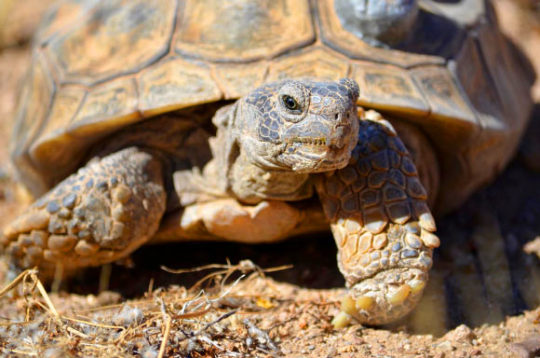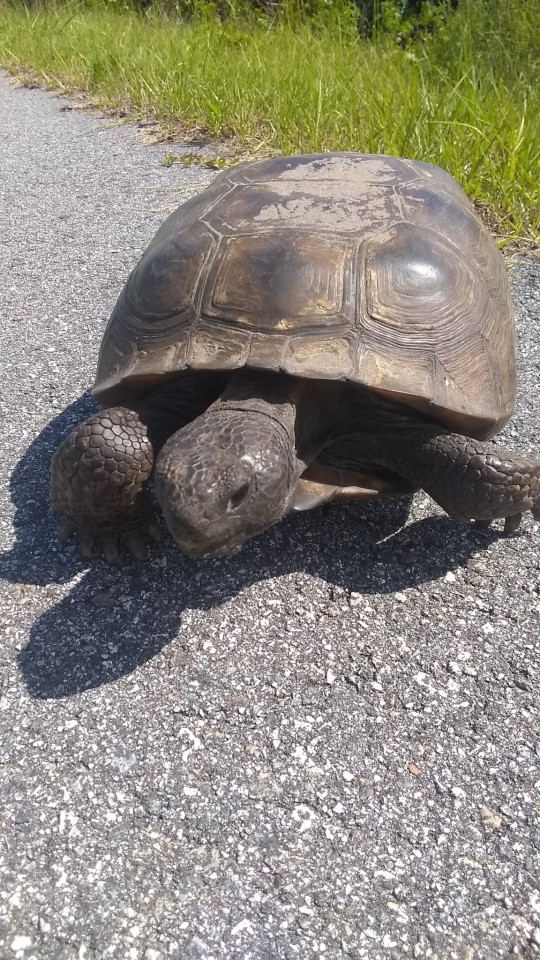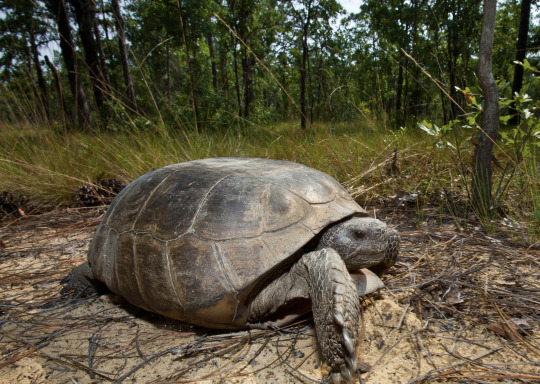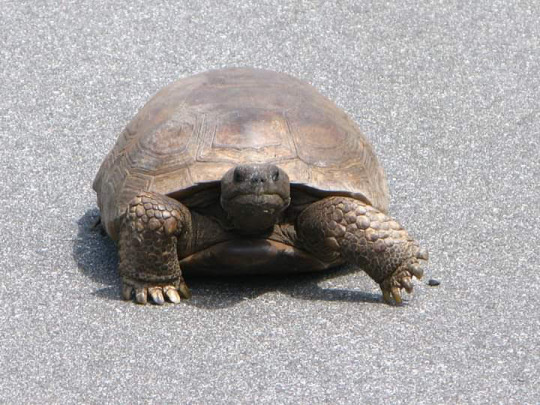#gopher tortoises
Explore tagged Tumblr posts
Text



Mosey On with the Mojave Desert Tortoise
Also known as the California desert tortoise, or more simply the desert tortoise, Gopherus agassizii is one of the few tortoise species native to North America. As its name implies, it is found only in the Mojave and Sonoroan deserts, from northern Mexico into the southwestern United States; there it is the state reptile of California and Nevada. Their habitat consists mainly of of desert scrub, where temperatures can reach over 60 °C (140 °F); however, in the southern reaches of its range, the desert tortoise can also be found in tropical deciduous forests.
To beat the heat, G. agassizii digs burrows where they can rest when its too hot or too cold to forage, and where they can aestivate during the hottest months of the summer and hibernate in the winter. These burrows can be quite extensive, reaching 10 m (32 ft) long, and up to 25 tortoises may share the same burrow. Individuals will often dig out several burrows in their territory, which can range anywhere from 3 to 25 hectares (7 to 61 acres). Many of these burrows will also become homes for other animals, including rattlesnakes, gila monsters, squirrels, burrowing owls, and quail.
Like all tortoises, the Mojave desert tortoise is herbivorous. Most of its food is grass, but due to the limited choice in the desert they may also consume wildflowers, shrubs, and cacti-- both fruits and new growth. Due to their hard shells, this species has few predators as adults, but hatchlings are vulnerable to foxes, coyotes, birds of prey, and gila monsters.
Very little rain falls in the desert, and so the desert tortoise is well adapted to do without; the species stores up to 40% of its body weight in water in its bladder, to be absorbed later. Individuals will also dig shallow 'watering holes' in the ground, to be visited after rainfall. G. agassizii also gets much of its water content from its diet, and can go up to a year without drinking.
Desert tortoises typically mate in the spring, from March to May, though mating can continue until autumn. Males seek out and fight each other for access to females, typically by ramming each other or attempting to flip each other over. However, this species is also one of the few known to engage in homosexual activity, particularly between males. Because this is not a species that mates for life, or maintains strict social hierarchies, the purposes of this intercourse is unknown.
Females can store sperm for up to eighteen months, and typically lay their eggs in the following year from May to July in clutches of 3 to 8. These eggs are laid in a deep nest dug into the ground, and take 90 to 135 days to hatch. Young emerge in the fall, and receive no parental care. If they survive, individuals may take between 10 to 16 years to become fully mature, and can live to be 80 years old.
Desert tortoises are well adapted to blend into their environments. The shell is typically a brown or dull yellow, while the body is tan or dusty grey. There is little difference between males and females, save that males are slightly bigger and have a concave plastron (lower shell) to accommodate mounting onto a female. The species is medium sized, ranging between 11 to 23 kg (24.23 to 50.66 lb) in weight and 25 to 36 cm (10 to 14 in) in length.
Conservation status: The IUCN has ranked the Mojave desert tortoise as Critically Endangered. Their primary threats include habitat fragmentation and loss, predation by feral dogs, and road mortality. The population is estimated to have declined by 90% since the 1980s. However, conservation programs are being implemented to preserve critical habitat, and several zoos and conservancies have captive breeding programs for the species.
If you like what I do, consider leaving a tip or buying me a ko-fi!
Photos
Dana Wilson
Bruce D. Taubert
Sandra Leander
#mojave desert tortoise#Testudines#Testudinidae#gopher tortoises#tortoises#turtles#reptiles#deserts#desert reptiles#scrubland#scrubland reptiles#central america#north america#southern north america#animal facts#biology#zoology
232 notes
·
View notes
Text

From the 2019 archives! A Gopher Tortoise! 😍
#tortoise#tortoises#gopher tortoise#gopher tortoises#titusville#spacecoast#florida#brevardcounty#centralflorida
129 notes
·
View notes
Text

Gopher Tortoise (Gopherus polyphemus)
Taken at Turkey Creek Sanctuary in Palm Bay, FL
#gopher tortoise#gopher tortoises#tortoise#tortoises#animal#animals#animal photography#wildlife#wildlife photography#nature#nature photography#photography#florida#florida photographer#florida photograhy#turkey creek sanctuary#turkey creek#wildlife sanctuary#nature trail#nature trails#nikon camera#nikon photography#nikon d3500#Gopherus polyphemus
16 notes
·
View notes
Photo

A hero! Click through to see more pics and see if there is something you can do.
Also? Florida? Come on! Enough with these policies that risk the lives of endangered species.
Written by Laura Guttridge of Florida
I have been a volunteer for the Vero Beach Humane Society for many years. As a volunteer, I got notice from them that a 38 acre site in Vero Beach was under construction. Unfortunately, this land was the home to dozens of the endangered gopher tortoises. A controversial state law in Florida allows developers to pay into a land management program, and then plow over gopher tortoise burrows condemning the tortoises inside to a slow death. The entombed tortoise can live for up to 6 months underground before dying of starvation and suffocation.
Typically citizens are not allowed to re-locate gopher tortoises. However, The Florida Fish and Wildlife conservation commission changed its rules, putting aside the required complicated permitting process typically required before relocating gopher tortoises, so we could rescue them.
Ilka Daniels, director of outreach services for the VBHS, spearheaded the efforts, and for the first time regular citizens were allowed to relocate the endangered gopher tortoises. We would wake up early every morning and search the site for wandering tortoises, and we also set up bucket traps to catch them, so we could get them out of harms way. We even excavated burrows, digging deep into their tunnels to find them. One tortoise we rescued was injured and needed to be rehabilitated. All the others we were able to find and save were measured, weighed, numbered and photographed before being sent to a holding pen, until they could be release into their new 18 acre preserve. They would be taken outside daily to roam in the Florida sunshine and eat fresh grass while they waited to be released into their new home.
At the end of our rescue, which took months, we managed to saved 31 of the endangered gopher tortoises. Private land owners can actually be provided with financial incentives by establishing tortoise preserves. Anyone who has ever had the opportunity to get to know one of these amazing
Read more: http://www.care2.com/causes/volunteers-stop-bulldozers-from-burying-tortoises-alive.html#ixzz205Qs0mko
6 notes
·
View notes
Text

Excerpt from this story from WTSP:
New research is showing that the majority of gopher tortoises could be at risk of extinction in less than 80 years.
According to a study from the Center for Biological Diversity, a new model that details population viability for the tortoises predicts that less than 1% of the species will be around by the year 2100.
This comes after a previous model was discovered to have several errors and overestimated future tortoise populations. It stated that 67% would be around in the same time period.
The flawed model was used so the U.S. Fish and Wildlife Service could deny the species protections from the Endangered Species Act back in 2022, the study explains.
“The previous model was far too flawed to use as a basis for decision making,” said Kevin Shoemaker, Ph.D., a professor of population ecology, in a statement. “I hope the Service does the right thing and re-evaluates their decision. In the meantime, researchers should move quickly to develop a more realistic model to support conservation decisions for this ecologically important species.”
Other errors discovered in the model include a movement of gopher tortoises that produced an "inadvertent positive feedback loop," indicating that the populations were growing faster than biologically possible.
The study also learned the previous model accelerated the rate of sexual maturation of younger gopher tortoises, causing inflated population growth predictions.
“Demographic models are powerful predictive tools for wildlife management decisions, but it’s critical that they be constructed correctly and that the parameters are based on sound scientific data. Unfortunately, the original model that was used to predict the future survival of gopher tortoise populations was significantly flawed and resulted in an erroneous decision by the Service,” said Matthew Aresco, Ph.D., biologist and board member at Nokuse Education, Inc, in a statement.
Researchers explain that the U.S. Fish and Wildlife Service denied protections from the Endangered Species Act for gopher tortoise populations in Florida, Georgia, South Carolina and most of Alabama. Tortoises in Louisiana, Mississippi and western Alabama were allowed protections.
4 notes
·
View notes
Photo

Photo credit: Andrea Westmoreland
1 note
·
View note
Text
FWC July 20 workshop in Pasco County
FWC July 20 workshop in Pasco County
FWC July 20 workshop in Pasco County gives local governments ways to conserve gopher tortoises
The Florida Fish and Wildlife Conservation Commission (FWC) is holding regional workshops this summer to present information on opportunities for local governments to help conserve gopher tortoises in Florida.
The goal of these workshops is to identify ways cities and counties can participate in…
View On WordPress
0 notes
Text
When I was like 7 we moved somewhere that had tortoises that would visit the backyard. They were varying sizes some about basketball sized to some that where as high as my knee. We would give them dandelions and pet them. Eventually they started just following us around. We even used sidewalk chalk to write their names on them. It was MAGICAL! It was also massively illegal. They were gopher tortoises and an endangered species. I cried when I found out. The first time they visited after I found out Verona started hauling ass towards me and my massive dandelion collection he was convinced I had at all times and I called him doodoo that had to go away because I didn't want to go to jail. My grandma took a video of them mating once. I still have the VHS.
0 notes
Link
By Daniel Wallis MIAMI (Reuters) - Wildlife authorities in Florida caught a man who killed and ate 15 gopher tortoises and planned to slaughter 11 more of the threatened reptiles, a spokeswoman said on Thursday. The Florida Fish and Wildlife Conservation Commission said a tip-off led an officer to woods in Citrus County on Florida's west coast where he found tire tracks and shells dumped on the ground. Returning the next day, he found a container holding 11 live gopher tortoises. "He hid himself and waited, figuring the subject would return that afternoon," the FWC said in a statement, adding that when the man came back he admitted to feasting on the threatened species. Source: Reuters
0 notes
Text
Look For Gopher Tortoises Out On A Spring Stroll
Look For Gopher Tortoises Out On A Spring Stroll
April 7, 2014
Photos available on FWC’s Flickr site: Go to: https://flic.kr/s/aHsjyKJjoL.
Suggested Tweet: Suggested Tweet: Drivers! @MyFWC says to be alert for slow-moving gopher #tortoises: http://content.govdelivery.com/accounts/FLFFWCC/bulletins/afa693 #Florida
Look for gopher tortoises out on a spring stroll
A gopher tortoise strolling across a road or through a backyard or field is…
View On WordPress
#cedar key#faraway inn#farawayinn.com#florida#Gopher Tortoises#Gulf Of Mexico#Places To See#Things To Do#Turtles
0 notes
Text



Going to Ground with the Gopher Tortoise
The gopher tortoise, sometimes specified as the Florida gopher tortoise (Gopherus polyphemus), is a species of tortoise found only in the southeastern United States. They require highly specialized habitats of dry, sandy soils, few trees, and a variety of low-growing vegetation. These habitats include coastal scrub, pine flat-woods, and sparse prairie.
As their name implies, gopher tortoises spend a large part of their time underground. They are widely known for digging large burrows, on average 4.5 m (14 ft) in length and 2 m (6.5 ft) deep. These burrows are particularly used at night and during the winter, where they can maintain a steady temperature throughout the year. Individuals maintain a relatively small home range around their burrow(s), up to 1.6 acres. Within this range, they forage on a wide variety of grasses, flowers, and shrubs. Gopher tortoises are also predated on by a variety of animals; eggs and juveniles are vulnerable to raccoons, coyotes, bobcats, skunks, birds of prey, and snakes. Adults are more shielded, but can still be coyotes, bobcats, Florida black bears, and Florida cougars.
Like other tortoises, G. polyphemus is heavily armored by a thick shell encasing the body. When threatened, individuals can pull their heads and limbs inside the shell for protection. Adults can reach a maximum length of 38.7 cm (15.24 in) and an average mass of 5.5 kg (193.83 oz), with females usually being slightly larger than males. The coloration is rather dull to blend into their surroundings, usually dark brown, tan, or grey on top and lighter tan on the bottom of the shell.
Mating for Florida gopher tortoises can occur from March through December. When they are ready to mate, males court females by bobbing their heads and walking in circles around the female. If she reciprocates, she may allow the male to mount; this process can be repeated several times over the course of several hours. Both sexes will mate with multiple partners throughout the season. After mating, the female digs a large hole and lays a clutch of 5-8 eggs. These eggs take 80 to 100 days to hatch, and young are immediately independent. Young are extremely vulnerable to predation, but those that survive reach full maturity between ages 9 to 21. Individuals can live up to 70 years in the wild.
Conservation Status: Florida gopher tortoises are considered Vulnerable by the IUCN. The species is threatened primarily by habitat destruction and fragmentation.
Photos
Florian Marchner
Amanda Hurst
Charles Warren
#florida gopher tortoise#Testudines#Testudinidae#gopher tortoises#tortoises#turtles#reptiles#deserts#desert reptiles#scrubland#scrubland reptiles#evergreen forest#evergreen forest reptiles#north america#southern north america#animal facts#biology#zoology#ecology
139 notes
·
View notes
Text
You can usually always spot a #gophertortoise burrow by the light coloured sand they dig up. This is the burrow of my friend I videoed next to Dollar General. The tortoise was in the burrow, about a foot from the entrance, and you can see it in the last two pics!





#tortoise#gopher tortoise burrows#gopher tortoises#gopher tortoise#turtles#titusville#spacecoast#florida#brevardcounty#centralflorida
110 notes
·
View notes
Text

Gopher Tortoise (Gopherus polyphemus)
Taken at Turkey Creek Sanctuary in Palm Bay, FL
#gopher tortoise#gopher tortoises#tortoise#tortoises#animal#animals#animal photography#wildlife#wildlife photography#nature#nature photography#photography#florida#florida photograhy#florida photographer#turkey creek sanctuary#wildlife sanctuary#nature trail#nature trails#nikon camera#nikon photography#nikon d3500#Gopherus polyphemus
9 notes
·
View notes
Text
Iguana by the Canal
Ft. Lauderdale is sometimes called the "Venice of America" because it has a ton of canals - a very intricate and expansive system of narrow fingers of water reaching out between the Atlantic and the Everglades. You can even take a Gondola ride on some of the canals. A long time ago the canals were very wide and hard to cross. Now suburbs and sidewalks and bridges and wider and wider roads encroach on the canals, pushing their banks closer and closer toward each other.
But nature persists.
Driving west on Griffin Road on my way home from work, my attention was caught by a sauntering something. It wasn't a cat, or a dog, or a squirrel or a raccoon. It moved like an alligator. A baby one? I did a double take. It was an iguana!! It was huge, it was real, and it was just casually taking a stroll on the grass beside the canal, not three feet from the very busy street I was on. Did it escape some wretched owner's cage? I asked my parents, the Broward experts. No, they explained. The wild iguanas are everywhere here. The natives aren't as captivated and charmed by the wrinkly reptiles as I am. The people here deplore the iguanas because the lizards climb into their yards and destroy the landscaping.
I was missing my Gopher tortoises in Tampa. But wild iguanas will do.
0 notes
Text
Uncharismatic Fact of the Day
Although they may not look like it, tortoises can be fearsome fighters. When male Mojave desert tortoises meet, they try to flip each other over with the curved horns on their lower shells as a form of dominance.

(Image: A Mojave desert tortoise (Gopherus agassizii) by the US Fish and Wildlife Service)
If you like what I do, consider leaving a tip or buying me a ko-fi!
#mojave desert tortoise#Testudines#Testudinidae#gopher tortoises#tortoises#turtles#reptiles#uncharismatic facts
128 notes
·
View notes
Text

Of all my pics of Gopher Tortoises, this is hands down my favourite. I think it was posing for the pic. lol 🐢
#gopher tortoises#gopher tortoise#tortoise#tortoises#tortoises of tumblr#titusville#spacecoast#florida#brevardcounty#centralflorida#shelllife
28 notes
·
View notes